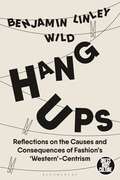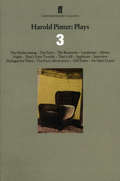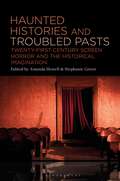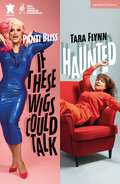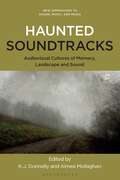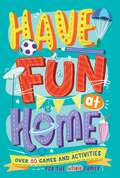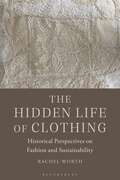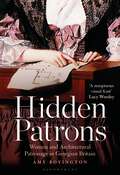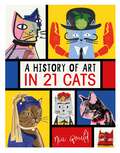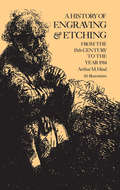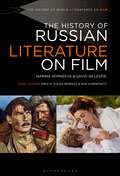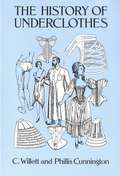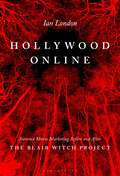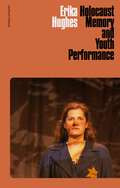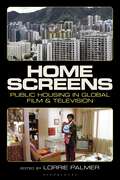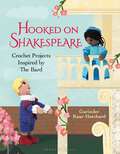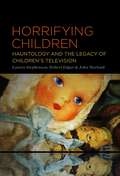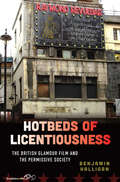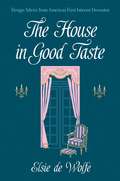- Table View
- List View
Hang-Ups: Reflections on the Causes and Consequences of Fashion’s ‘Western’-Centrism (Dress, Body, Culture)
by Benjamin Linley WildThe Covid-19 pandemic heightened people's awareness of long-standing inequalities within the fashion industry. Amid calls for greater accountability and ethical awareness, efforts are being made within and beyond the industry, chiefly in the cultural and education sectors, to decentralize fashion: to make the conception, creation and consumption of fashionable dress and appearance less 'western'-centric.Supporting this premise, Hang-Ups argues that purposeful and permanent change within the fashion industry and fashion education is more likely if it is understood how the contemporary industry became 'western'-centric. To institute effective change, it is necessary to revert to first principles and understand how the fashion industry developed into what it is today. During a period when the concepts of fashion, history and culture are being intensely scrutinized, and with suggestions they are reaching their nadir, the imperative to understand the extent to which they relate, and facilitate the presentation of people's fashionable bodies, is urgent. Hang-Ups explores the origins and consequences of the fashion industry's 'western'-centrism by focusing on nine binaries, defined in the crucible of empire, that continue to be sites of negotiation as the 'west's' traditions and ideals are contested by different cultural perspectives and changing global realities.
The Harmony Test (Modern Plays)
by Richard MolloyHe says, if we really wanna conceive now, he's got a little something he can sell me under the counter at a very reasonable price. It will not fail!Newlyweds Zoe and Kash are ready to start a family. Zoe wants to take a practical approach: fertility plans, vitamin supplements and a strict diet. Kash, on the other hand, would rather follow the advice of an intriguing man he just met in Holland and Barrett.Empty-nesters Naomi and Charlie have been living in matrimonial bliss for twenty odd years - or at least they had been according to Charlie. Frustrated and lonely, Naomi heads to the gym in search of a new lease on life. Instead, she finds Rocco – a much younger personal trainer willing to take a hands-on approach to the job…Richard Molloy's hilarious comedy The Harmony Test explores life's positives and negatives, from starting families, to ending marriages, and everything that comes in between. He and director Alice Hamilton collaborate for the second time following the hugely successful Every Day I Make Greatness Happen, which played Downstairs in 2018.This edition was published to coincide with the world premiere at London's Hampstead Theatre Downstairs in May 2024.
Harold Pinter Plays 3: The Homecoming; Old Times; No Man’s Land (Pinter, Harold Ser.)
by Harold PinterThis revised third volume of Harold Pinter's work includes The Homecoming, Old Times, No Man's Land, four shorter plays, six revue sketches and a short story. It also contains the speech given by Pinter in 1970 on being awarded the German Shakespeare Prize. The Homecoming 'Of all Harold Pinter's major plays, The Homecoming has the most powerful narrative line... You are fascinated, lured on, sucked into the vortex.' Sunday Telegraph 'The most intense expression of compressed violence to be found anywhere in Pinter's plays.' The Times Old Times 'A rare quality of high tension is evident, revealing in Old Times a beautifully controlled and expressive formality that has seldom been achieved since the plays of Racine.' Financial Times 'Harold Pinter's poetic, Proustian Old Times has the inscrutability of a mysterious picture, and the tension of a good thriller.' Independent No Man's Land 'The work of our best living playwright in its command of the language and its power to erect a coherent structure in a twilight zone of confusion and dismay.' The Times
Haunted Histories and Troubled Pasts: Twenty-First-Century Screen Horror and the Historical Imagination
Haunted Histories and Troubled Pasts speaks to how a transnational array of recent screen entertainments participate, through horror, in public discourses of history, the social and creative work of reshaping popular understanding of our world through the lens of the past.Contemporary film and television – and popular screen cultures more generally – are distinguished by their many and varied engagements with history, including participation in worldwide movements to reconcile past losses and injuries with present legacies. The chapters in this collection address themselves to 21st-century screen horror's participation in this widespread fascination with and concern for the historical - its recurrent reimagining of the relation between the past and present, which is part of its inheritance from the Gothic. They are concerned with the historical work of horror's spectral occupations, its visceral threats of violence and its capacity for exploring repressed social identities, as well as the ruptures and impositions of colonization and nationhood.Trauma is a key theme in this book, examined through themes of war and genocide, ghostly invasions, institutionalized abuse, apocalyptic threat and environmental destruction. These persistent, fearful reimaginings of the past can take many lurid – sometimes tritely generic – forms. Together, these chapters explore and reflect upon horror's ability to speak through them to the unspoken of history, to push the boundaries and probe the fault-lines and ideological impositions of received historical narratives – while reminding us that history and the historical imagination persist as sites of contention.
Haunted & If These Wigs Could Talk (Modern Plays)
by Tara Flynn Panti BlissTHISISPOPBABY & The Abbey Theatre presentIf These Wigs Could Talk by Panti BlissIf These Wigs Could Talk meets Panti, a drag queen at fifty-three, after a lifetime of showbiz, shenanigans and making a show of herself, taking this moment to question what her purpose and place in the world is now. Via salacious stories, impassioned polemics, some seriously funny soul searching and a few unvarnished truths, Panti takes us from rural Mayo to London's glittering West End to the Ambassador's residence in Vienna where, along the way, the answer to the question presents itself when she least expects it. Panti warmly invites you to learn from her mistakes, laugh at her failures and revel in her triumphs.Haunted by Tara FlynnWhat happens when you hit the floor and lose all of your marbles? Ask Tara Flynn: a fame-adjacent actor turned advocate for the campaign to Repeal Ireland's Eighth Amendment. The country voted Yes and the whirlwind of publicity and abuse came to an end, and crashing to the floor is where Tara found herself. Down there, she realised the whirlwind had conveniently kept her from dealing with the death of her dad.This is one woman's journey back from the floor. A funny, moving tale of grief, campaigning for civil rights, the offline impact of online abuse, crashing to the ground and fighting to tell your own story.
Haunted Soundtracks: Audiovisual Cultures of Memory, Landscape, and Sound (New Approaches to Sound, Music, and Media)
The turn of the millennium has heralded an outgrowth of culture that demonstrates an awareness of the ephemeral nature of history and the complexity underpinning the relationship between location and the past. This has been especially apparent in the shifting relationship between landscape, memory and sound in film, television and other media. The result is growing interest in soundtracks, as part of audiovisual culture, as well as an interest in the spectral aspects of culture more generally. This collection of essays focuses on audiovisual forms that foreground landscape, sound and memory. The scope of inquiry emphasises the ghostly qualities of a certain body of soundtracks, extending beyond merely the idea of 'scary films' or 'haunted houses.' Rather, the notion of sonic haunting is tied to ideas of trauma, anxiety or nostalgia associated with spatial and temporal dislocation in contemporary society. Touchstones for the approach are the concepts of psychogeography and hauntology, pervasive and established critical strategies that are interrogated and refined in relation to the reification of the spectral within the soundtracks under consideration here.
Have Fun at Home
by Alison Maloney Christopher StevensTime at home is much more fun when it is shared. Whatever games and activities you dream up, they take on a whole new meaning when the whole family get involved. So whether it's the weekend, the holidays or that precious free hour at the end of a busy day, here are over 80 ideas for activities that will have everyone grinning from ear to ear. If you've got energy to burn, this book contains sports and games ideas to exercise both mind and muscles. If it's new toys you want, there are all sorts of ingenious and inexpensive playthings to make within these pages. If you need ideas for indoor fun, there's lots to do when it's raining outside. And if you want to sneak a little education into playtime, you'll even find a few facts hidden among the fun.
The Hidden Life of Clothing: Historical Perspectives on Fashion and Sustainability
by Rachel WorthSince the democratisation of the clothing industry in the early 19th century, buyers have become increasingly disconnected from the creative and human aspects of the production of clothing. Arguably clothing is now valued less for its aesthetic qualities or because of the hours spent in its making, but more for the extent to which it serves current 'fashion'. In a climate of increasing anxiety about the environmental and social impact of the contemporary global fashion industry, Rachel Worth suggests that, rather than seeking solutions only in the present, looking to history can assist in understanding better the challenges consumers face today in making decisions about the contents of their wardrobes, which, in turn, will impact on the nature of the future global fashion industry. She does not seek to offer simplistic historical solutions to contemporary problems, but explores ways in which it might be possible to bridge divides between knowledge of the past, current individual choice, and possible directions for future action. The more we know about our clothes, the less likely it is that we will wear an item of clothing only a few times before replenishing it with newer purchases that are 'on trend'. By taking ownership of our personal clothing choices rather than feeling pressurised to respond to sophisticated marketing and to 'influencers', this book suggests how we might rethink our wardrobes in philosophical and practical ways in order to create a sense of order and beauty in our lives and to wrest control back from the increasing chaos of seemingly endless choice that perpetuates unsustainable, impersonal and fast fashion.
Hidden Patrons: Women and Architectural Patronage in Georgian Britain
by Amy BoyingtonAn enduring myth of Georgian architecture is that it was purely the pursuit of male architects and their wealthy male patrons. History states that it was men who owned grand estates and houses, who commissioned famous architects, and who embarked upon elaborate architectural schemes. Hidden Patrons dismantles this myth - revealing instead that women were at the heart of the architectural patronage of the day, exerting far more influence and agency than has previously been recognised. Architectural drawing and design, discourse, and patronage were interests shared by many women in the eighteenth century. Far from being the preserve of elite men, architecture was a passion shared by both sexes, intellectually and practically, as long as they possessed sufficient wealth and autonomy.In an accessible, readable account, Hidden Patrons uncovers the role of women as important patrons and designers of architecture and interiors in eighteenth-century Britain and Ireland. Exploring country houses, Georgian townhouses, villas, estates, and gardens, it analyses female patronage from across the architectural spectrum, and examines the work of a range of pioneering women from grand duchesses to businesswomen to lowly courtesans. Re-examining well-known Georgian masterpieces alongside lesser-known architectural gems, Hidden Patrons unearths unseen archival material to provide a fascinating new view of the role of women in the architecture of the Georgian era.
A History of Art in 21 Cats: From the Old Masters to the Modernists, the Moggy as Muse: an illustrated guide
by Nia GouldArt history has been given a fun feline makeover. Discover the basics of important art movements through a host of beautifully illustrated cats, each one inspired by a specific period in art history. From Surrealism to Cubism, Abstract Expressionism to Ancient Egyptian art, these creative cats will introduce you to key themes and provide you with all of the inspiration you need if you want to create your own version.Each illustrated cat comes with an overview of the art movement that it represents, plus a breakdown of the cats features, explaining the relevance of each. Accompanied by fun, informative captions, each element - from faces and fur to patterns, shapes and colours - provides a quirky, accessible insight into the history of art.More than just a reference book, A History of Art in 21 Cats is perfect for art enthusiasts and cat lovers alike.
A History of Engraving and Etching
by Arthur M. HindArthur Mayger Hind (1880–1957) was a leading historian of engraving, one of the most highly respected art historians of modern times. Keeper of Prints and Drawings at the British Museum and Professor of Fine Art at Oxford, he was the author of the most complete history of etching and engraving that has yet been written. This book, formerly out of print for many years, contains references to every etcher or engraver worthy of mention from the early fifteenth century to 1914, and it gives a fair account of influences, artistic repercussions, and accomplishments of each individual.Beginning with a chapter on processes and methods of the twin arts, in which he covers line-engraving, etching, biting and stopping-out, tone processes, the tools used in the various methods, and so on, the author proceeds with a text that is fabled among artists, art historians, teachers, and students for its richness of detail and the brilliance of its author’s obvious genius for research and criticism. He begins with the anonymous engravers of the fifteenth century, moves through Holland, Italy, and Germany to the great masters of engraving and the beginnings of etching in the sixteenth century, through the portrait engravers, master etchers, the practitioners of mezzotint, aquatint, crayon manner and stipple, and color print makers, to modern etching in the period prior to World War I. All along the way there are illustrations: over 100 magnificent works by Dürer, Finiguerra, Cranach, Lucas Van Leyden, Parmigiano, Van Dyck, Rembrandt, van Ruysdael, Blake, Tiepolo, Piranesi, Turner, Boucher, Goya, Millet, Whistler, and scores of others. All but seven of these plates have been reproduced from new photographs and are even sharper and clearer than those in the original editions of Hind's great text.As an aid to students of art history, there is a massive Index of more than 2,500 artists mentioned in the text, with their dates and brief individual biographical data. Furthermore, there is a classified chronological list, arranged by country, of important artists, movements, and styles, and the engravers and etchers who were influenced by them. Finally, there is a bibliography that is valuable for further reference work.
The History of Russian Literature on Film (The History of World Literatures on Film)
by Marina Korneeva David GillespieUnlike most previous studies of literature and film, which tend to privilege particular authors, texts, or literary periods, David Gillespie and Marina Korneeva consider the multiple functions of filmed Russian literature as a cinematic subject in its own right-one reflecting the specific political and aesthetic priorities of different national and historical cinemas. In this first and only comprehensive study of cinema's various engagements of Russian literature focusing on the large period 1895-2015, The History of Russian Literature on Film highlights the ways these adaptations emerged from and continue to shape the social, artistic, and commercial aspects of film history.
The History of Underclothes
by C. Willett Cunnington PhiIlis Cunnington". . . thoroughness and most impressive scholarship . . . much entertaining detail and . . . pleasant humour." — The Times Literary Supplement (London)Underwear — practical garments with a utilitarian function or body coverings that serve an erotic purpose? As this fascinating and intelligently written study shows, the role played by underclothing over the last several centuries has been a varied one.In a well-documented, profusely illustrated volume combining impressive scholarship with an entertaining, often humorous style, two distinguished clothing historians consider undergarments worn by the English over the past 600 years. Beginning with the Middle Ages, the authors cover centuries of clothing history, including the Tudor period, the Restoration, the Victorian and Edwardian eras, and the twentieth century up to the eve of World War II. Drawing on extensive, research, the Cunningtons illuminate the role and function of underwear: it protected the wearer against the elements, supported costume shapes, served as an erotic stimulus, symbolized class distinctions, and fulfilled other social, sanitary, and economic functions. Enhancing the detailed, comprehensive text are more than 100 period illustrations and photographs depicting a laced-up bodice of the twelfth century, embroidered linen drawers of the sixteenth century, a hooped petticoat support in bentwood (c. 1750), footed long drawers (1795), nineteenth-century bustles, early nineteenth-century corsets for men, "Frillies for the Tiny Lady" (1939), and much more. A bibliography, appendix, and index complete a valuable reference work that will appeal to costume historians, sociologists, and other readers.
Hollywood Online: Internet Movie Marketing Before and After The Blair Witch Project
by Dr. Ian LondonHollywood Online provides a historical account of motion picture websites from 1993 to 2008 and their marketing function as industrial advertisements for video and other media in the digital age.The Blair Witch Project is the most important example of online film promotion in cinema history. Over the last thirty years only a small number of major and independent distributors have converted internet-created buzz into box-office revenues with similar levels of success. Yet readings of how the film's internet campaign broke new ground in the summer of 1999 tend to minimize, overlook or ignore the significance of other online film promotions. Similarly, claims that Blair initiated a cycle of imitators have been repeated in film publications and academic studies for more than two decades. This book challenges three major narratives in studies about online film marketing: Hollywood's major studios and independents had no significant relationship to the internet in the 1990s; online film promotions only took off after 1999 because of Blair; and Hollywood cashed-in by initiating a cycle of imitators and scaling up corporate activities online. Hollywood Online tests these assumptions by exploring internet marketing up to and including the film's success online (Pre-Blair, 1993-9), then by examining the period immediately after Blair (Post-Blair, 2000-8) which broadly coincides with the rise and decline of DVD, as well as the emergence of the social media sites MySpace, Facebook and Twitter.
Holocaust Memory and Youth Performance
by Erika HughesThrough an examination of children's and youth plays and performances about the Holocaust from Germany, Israel, and the United States, this book offers an entirely new way of looking at the vital role of youth performance in coping with the legacy of historical tragedy. As the first book-length critical examination of this subject, Holocaust Memory and Youth Performance considers plays that are produced by major theatre companies alongside performances written by young authors and pieces taken from the diaries and memoirs of those who experienced the Holocaust as children or adolescents. While youth-focused plays about the Holocaust have been in the repertories of top professional companies throughout the world for decades and continue to be performed in theatres, schools, and community centers, they are often neglected in concentrated and comparative studies of Holocaust theatre. Erika Hughes fills this gap by examining plays (including The Diary of Anne Frank and Ab heure heißt Du Sara), musicals, performances, scripts, a rock concert, a performance on Instagram, and pedagogically-focused works of applied theatre – a diverse collection of performances for young audiences that tell the stories of young people who experienced the Holocaust. Adopting Hannah Arendt's notion of natality as a powerful framework, this study examines the ways in which youth-theatre performances make a vital contribution to intergenerational witnessing and the collective memory of the Holocaust.
Home Screens: Public Housing in Global Film & Television
How do film and television makers around the world depict public housing? Why is public housing so often chosen as the backdrop for drama, horror, social critique, rebellion, violence, artistic creativity, explorations of race relations and political intrigue?Home Screens answers these questions by examining the ways in which socialized housing projects around the world are represented on screen. The volume brings together a diverse group of interdisciplinary scholars, who explore documentary and fictional portrayals of the architecture of public housing, and the communities that inhabit it, ranging from the 1950s to the present. Examining international film and media texts such as Die Architekten (1990), Swagger (2016), Cooley High (1975), Mee-Pok Man (1995), Treme (2010–2013), Mamma Roma (1962), The Pruitt-Igoe Myth (2011), and Below the Lion Rock (1972–1976), essays within this book consider public and private attitudes toward socialised housing, explaining how onscreen representations shape perceptions of these ubiquitous, often-stigmatized urban locations.
Homes for a Changing Climate: Adapting Our Homes and Communities to Cope with the Climate of the 21st Century
by Will AndersonAn exploration into the history of our collective response to the challenges of extreme weather conditions and climate.At the beginning of the twenty-first century, the world finally woke up to the reality of climate change and began the arduous task of freeing itself from dependence on fossil fuels. But the time lag in the Earth's ecosystem is such that our best efforts to cut carbon today will make little difference to the changing climate of the next 30 years. As we work towards a secure, low-carbon future, we must address the changes that are already taking place in the planet's climate. We must learn to live with higher temperatures, intense rainstorms, rising sea levels and prolonged drought. We must also confront the secondary impacts of climate change, especially on energy and food security.Britain has a mild, temperate climate where occasional weather extremes tend to have serious impacts because we are simply not prepared for them. Yet across the world, communities have been living with such extremes for millennia. If we have the imagination to learn from others and rethink the ways we build and live together, we can face this unsettling future with confidence.Homes for a Changing Climate celebrates this collective wisdom, exploring traditional and contemporary responses to the challenges of climate and illustrating the many ways in which houses can be designed, built and adapted to cope with these challenges. Examples are drawn from across Europe including the supervolcano of Thera, the 100mph winds of the Western Isles, and the cutting-edge eco-building projects in Britain. Based on the climate projections for the UK published by the Met Office in June 2009, Homes for a Changing Climate combines inspiring case studies, striking photography and practical advice to create a book of imagination and hope in uncertain times.
Hooked on Shakespeare: Crochet Projects Inspired by The Bard (Hooked On...)
by Gurinder Kaur Hatchard15 projects featuring more than 30 step-by-step amigurumi inspired by the works of William Shakespeare.This fabulous collection of creations ranges from the iconic Romeo and Juliet to Hamlet and the Ghost, and from the Three Witches from Macbeth to Bottom and Titania from A Midsummer Night's Dream. Not forgetting the one and only Woolliam Shakespeare himself.Each project features an introduction to the play and its characters, followed by colourful step-by-step instructions. The easy-to-make designs include fully illustrated stitch basics, perfect for beginning crocheters as well as advanced crochet enthusiasts.
Horrifying Children: Hauntology and the Legacy of Children’s Television
Horrifying Children examines weird and eerie children's television and literature via critical analysis, memoir and autoethnography.There has been an explosion of interest in the impact of children's television and literature of the late twentieth century. In particular, the 1970s, '80s and '90s are seen as decades that shaped a great deal of the contemporary cultural landscape. Television of this period dominated the world of childhood entertainment, drawing freely upon literature and popular culture, like the Garbage Pail Kids and Stranger Things, and much of it continues to resonate powerfully with the generation of cultural producers (fiction writers, screenwriters, directors, musicians and artists) that grew up watching the weird, the eerie and the horrific: the essence of 21st-century Hauntology. In these terms this book is not about children's television as it exists now, but rather as it features as a facet of memory in the 21st century. As such it is the legacy of these television programmes that is at the core of Horrifying Children. The 'haunting' of adults by what we have seen on the screen is crucial to the study. This collection directly addresses that which 'scared us' in the past insomuch as there is a correlation between individual and collective cultural memory, with some chapters providing an opportunity for situating existing explorations and understandings of Gothic and Horror TV within a hauntological and experiential framework.
Horror That Haunts Us: Nostalgia, Revisionism, and Trauma in Contemporary American Horror Film and Television
Horror’s pleasures fundamentally hinge on looking backward, either on destabilising trauma, or as a period of comfort and happiness which is undermined by threat. However, this stretches beyond the scares on our screens to the consumption and criticism of the monsters of our past. The horror films of our youth can be locations of psychological and social trauma, or the happy place we go back to for comfort when our lives become unsettled. Horror That Haunts Us: Nostalgia, Revisionism, and Trauma in Contemporary American Horror is a collection of essays that brings together multiple theoretical and critical approaches to consider the way popular horror films from the last fifty years communicate, embody, and rework our view of the past. Whether we look at our current relationship to the scary movies of decades ago as personal or cultural memory, the way historical and sociopolitical events and frameworks – especially traumas – reframe the way we look at our pasts, or even the way recent horror films and video games look back at our past (and the past of the genre itself) through a filter of experience and history, this collection will show the close relationship between nostalgia and popular horror. These essays also demonstrate a range of unique and diverse points of view from both established and emerging scholars on the subject of horror and the past. Edited by seasoned horror experts Karrá Shimabukuro and Wickham Clayton, Horror That Haunts Us is a book with the aim of examining why we return again and again to certain popular horror films, either as remakes or reboots or as the basis for pastiche and homage.
Hotbeds of Licentiousness: The British Glamour Film and the Permissive Society
by Benjamin HalliganHotbeds of Licentiousness is the first substantial critical engagement with British pornography on film across the 1970s, including the “Summer of Love,” the rise and fall of the Permissive Society, the arrival of Margaret Thatcher, and beyond. By focusing on a series of colorful filmmakers whose work, while omnipresent during the 1970s, now remains critically ignored, author Benjamin Halligan discusses pornography in terms of lifestyle aspirations and opportunities which point to radical changes in British society. In this way, pornography is approached as a crucial optic with which to consider recent cultural and social history.
Hotbeds of Licentiousness: The British Glamour Film and the Permissive Society
by Benjamin HalliganHotbeds of Licentiousness is the first substantial critical engagement with British pornography on film across the 1970s, including the “Summer of Love,” the rise and fall of the Permissive Society, the arrival of Margaret Thatcher, and beyond. By focusing on a series of colorful filmmakers whose work, while omnipresent during the 1970s, now remains critically ignored, author Benjamin Halligan discusses pornography in terms of lifestyle aspirations and opportunities which point to radical changes in British society. In this way, pornography is approached as a crucial optic with which to consider recent cultural and social history.
The House in Good Taste: Design Advice from America's First Interior Decorator (Dover Architecture)
by Elsie De Wolfe"Good taste can be developed in anyone, just as surely as good manners are possible to anyone. And good taste is as necessary as good manners," declared Elsie de Wolfe, the "first lady" of American interior design. Although de Wolfe decorated the homes of wealthy, socially prominent clients, she always maintained that her vision of elegant but comfortable living is attainable to all. This timeless 1913 book, written in a friendly, conversational tone, explains how to design, furnish, and decorate a house in order to make it a beautiful, useful, and livable home.De Wolfe pioneered the concept of the home as a representation of the owner's identity, and this book defines her decorating methods, philosophy, and approach to creating spaces for gracious entertaining. Part step-by-step manual and part aesthetic treatise, this volume advocates for simpler yet more refined decor. In contrast to the Victorian penchant for dark furniture, bric-a-brac, and heavy draperies, de Wolfe advised her readers to let in natural light, to replace gaudy colors with beige and ivory, and to abandon clutter. Her practical suggestions, illustrated by period photographs, illuminate the attitudes of a century ago while retaining their resonance for modern-day interior designers.
